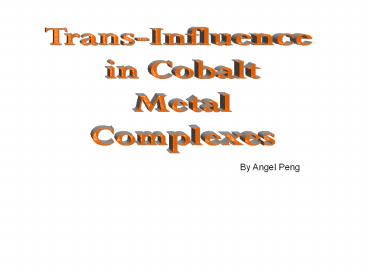Trans-Effect in Cobalt Metal Complexes PowerPoint PPT Presentation
1 / 19
Title: Trans-Effect in Cobalt Metal Complexes
1
Trans-Influence in Cobalt Metal Complexes
By Angel Peng
2
Introduction
- Hypothesis The nature of the X ligand can be
determined by observing the effects of the
metal-ligand bond trans to it. - General structure of compound used
Co(dimethylglyoxime)(pyridine)X - X ligands are CN, Br, CH3, SCN, and OH.
2 dimethylglyoxime moieties in its equatorial
plane stabilizes the unpaired electron in the
cobalt atom6
3
Background
- Trans influence is a change in the bond distance
between the metal and a ligand that is trans to
the ligand exerting the effect through the same
d-orbital interaction.1
Ligand exerting influence
Trans ligand
4
Nature of Ligands
- ?-donor
- (ex. NH3, CH3-, H-)
- ?-donor
- (ex. Cl-, OH-, NR2-)
- ?-acceptor
- (ex. CO, NO, CN-)
Pictures taken from ref 2.
5
Effect of Metal-Pyridine Bond
- ?-donor
- ?-acceptor
- ?-donor
Bond length shortens due to electron density
increase in the metal, building a stronger bond
between Co-pyridine
Metal electron density decreases causing a weaker
elongated bond between Co-pyridine.
Unmodified pictures taken from ref 3.
6
Synthetic Procedure
- Synthesis of Co(dimethylglyoxime)2(pyridine)X
- XCN, Br, SCN)4
- Step 1 Boil mixture 5 min. Step 2
Boil another 5 min. - Step 3 Boil another 5 min.
Solution of 5 mmol of KX or NaX in 5 mL water
added
6.25 mmol dimethylglyoxime
3.3 mmol cobalt nitrate hexahydrate
Solution of 2 mL of pyridine in 5 mL of THF added.
7
Synthetic Procedure Cont
- Step 4 Aerate for 20 min.
- Step 5 Collect crystals by vacuum filtration
- Step 6 Wash crystals with 5 mL water and ethanol
and 10 mL of diethyl ether. - Synthesis of Co(dimethylglyoxime)2(pyridine)OH
- - Replace step 2 with addition of 0.2 mL of
ammonia hydroxide instead of salt solution.
Air Pipe
8
Synthetic Procedure Cont
- Synthesis of Co(dimethylglyoxime)2(pyridine)CH35
- Continuing from step 6, Co(dimethylglyoxime)2(pyri
dine)Br of 0.8 mmol was mixed 5 mL of methanol
under argon atmosphere.
- 1.7 mmol of NaBH4 was added, followed by 1.5 mmol
of iodomethane. - Another 1.7 mmol of NaBH4 was added into the
solution - Stir for 15 min and then pour into 10 mL of cold
water. - Collect and wash crystals with 10 mL ether.
Ar. atmosphere setup
9
Results
-OH
-CN of dimethyl-glyoxime11
-CN
Co-pyridine stretch8 at 514.82 cm-1
Pyridine ring12
IR of Co(dimethylglyoxime)(pyridine)CN
All IR values taken from reference 7, unless
otherwise indicated.
10
Results
-SCN9
Co-pyridine stretch at 512.74 cm-1
IR of Co(dimethylglyoxime)(pyridine)SCN
11
Results
-CH3
Co-pyridine stretch 512.49 cm-1
IR of Co(dimethylglyoxime)(pyridine)CH3
12
Results
Co-Br10
Co-pyridine stretch
IR of Co(dimethylglyoxime)(pyridine)Br
13
Results
-OH
Co-pyridine stretch at 503.86 cm-1
IR of Co(dimethylglyoxime)(pyridine)OH
14
Discussion
- Cobalt-pyridine IR stretch in increasing
wavenumber according to trans ligand - Co-py bond shifting to lower wavenumbers
indicated a shortening of bond length. An
increase in electron density on the metal created
a stronger hold between the Co-pyridine.
15
Discussion
- Characteristics of OH
- Greatest electron density contribution on cobalt
atom - Oxygens lone pair electrons donated into metals
empty d-orbital - ?-donor
- Characteristics of Br
- Electron density contribution not as great due to
slight electron withdrawal from inductive effect - Partial ?-donor/?-acceptor
- Characteristics of CH3
- ?-donors
16
Discussion
- Characteristics of SCN
- Sulfur normally would contribute to metal
electron density as much as oxygen but the -CN
counters with its electron affinity nature. - Characteristics of CN
- Electrons from the metal fills the empty
?-orbital of CN. - Lowering electron density around cobalt decreases
the Co-py bond. - Mostly ?-acceptor and slightly ?-donor nature.
17
Conclusion
- Nature of ligands can be comparatively
characterized by observing the effect they have
on its metal trans bond. - Change in metal electron density and trans bond
length can be measured by IR analysis. - Originally intend to use iron-porphyrin as the
general compound in which the metal complex is
stabilized due electron contribution from the
porphyrin core to the - Metallation of iron into porphyrin was
unsuccessful after 4 attempts. - Extremely low percent yield was achieved after
many hours of reflux, but product was essentially
nonexistent. - Experiment can be improved with better solvent
(higher b.p.) and longer reflux time. - Experiment can be improved by using more ligands
to attain a broader range of characteristic
spectrum.
18
References
- 1.) Tadeusz Andruniow, Jadwiga Kuta, Marek Z,
Zgierski, Pawel M. Kozlowski, Molecular orbital
analysis of anomalous trans effect in cobalamins,
Chemical Physics Letters 410, (2005), 410-416. - 2.) http//www.chemistry.mcmaster.ca/courses/3Q03
2005.pdf - 3.) http//cnx.org/content/m15057/latest/ds.GIF
- 4.) Ndahi Naomi, Kolawole Gabriel, Cobalt(III)
complexes of diphenylglyoxime as possible
non-organometallic models of vitamin B12, South
African Journal of Science 101, Sept/Oct. 2005. - 5.) Roth Justine P, A Laboratory Manual for
Advanced Inorganic Chemistry, The Johns Hopkins
University, Maryland, Fall 2007. - 6.) Harwood James H., Shim Anne K., Polymers and
copolymers prepared or modified by using cobalt
complexes, US Patent 6602960, 5 Aug, 2003. - 7.) http//www.mpcfaculty.net/ron_rinehart/12A/IR/
primclue.htm - 8.) Gradinaru Julieta, Malinovskii
Stanislav,Trinuclear tris-Co(II) and
trans-cobaloxime type Co(III) complexes prepared
from Co(II) triflate precursor Synthesis
structure and properties, Polyhedron 25 (2006),
3417-3426.
19
Reference
- 9.) Lu G.W., Xia H.R., Zheng W.Q, Vibrational
Spectrum and Structure of CdHg(SCN)4 Single
Crystals, Physica status solidi (b), Vol 231,
Isssue 2, 554-560 - 10.) Meehan Paul R., Alyea Elmer C., Structural
and spectroscopic studies of cobalt(II) complexes
incorporating the bidentate phosphine ligand
Ph2PCH2Si(CH3)2CH2PPh2, Polyhedron, vol. 17,
issue 1 (1998), 11-16. - 11.) Brown Kenneth, Satyanarayana S. Infrared and
13C and 15N NMR Studies of Cyano(ligand)cobaloxime
s Evidence for Cobalt-to-Cyanide ?-Bonding,
Inorganic Chemistry, Vol 31, Issue 8 (1992),
1367. - 12.) Abdullah Ahmed, Huq Fazlul, Chowdhury
Ashraf, Studies on the synthesis,
characterization, binding with DNA and activities
of two cis-planaramineplatinum(II) complexes of
the form cis-PtL(NH3)Cl2 where L
3-hydroxypyridine and 2,3-diaminopyridine, BMC
Chemical Biology 2006, 63

